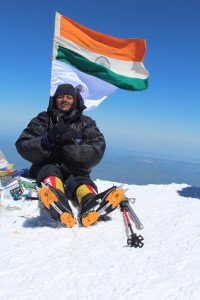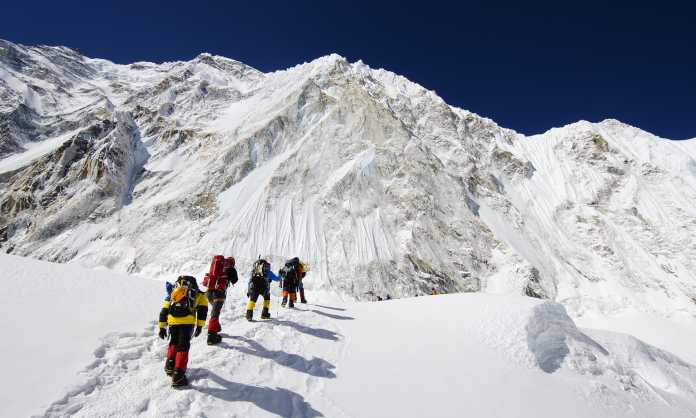To conquer Mount Everest and five of the highest summits in the world is no mean feat. But tougher was the challenge and higher were the skies for 28-year-old amputee and mountaineer Arunima Sinha. Stuti Nabbaza talks to her about her struggles

FROM 6 YEARS AGO, WHEN YOU WERE A NATIONAL VOLLEYBALL CHAMPION TO UNDERTAKING MISSION SEVEN SUMMIT, HOW WOULD YOU DESCRIBE YOUR JOURNEY?
I can say that there is no substantial difference between volleyball and what I am doing today, except the change in roots. Mentally speaking, there is no change whatsoever. Because the determination which comes with playing volleyball is similar to the determination which comes with mountaineering. The only difference being, volleyball is about winning and losing. But in mountaineering, there is no scope for mistakes. We win or we pay the price of losing with our lives. I feel that discipline and rules are very important to follow in whatever we pursue in life.
AFTER THE ACCIDENT, WHEN YOU WERE RECOVERING FROM YOUR AMPUTATION, WHAT INSPIRED YOU TO BE PHYSICALLY AND MENTALLY STRONG?
In any situation, it is very important for one to be mentally strong. When I was in the hospital, I realized that there is no use regretting over what is done. I decided to begin by making my amputated leg my biggest strength. At that time, Yuvraj Singh’s determination to fight cancer inspired me. Swami Vivekananda’s writings also generated energy within me. His rules and discipline helped me mentally prepare myself.
WHEN YOU DECIDED TO CLIMB THE EVEREST, WHO SUPPORTED YOU?
My family has always been my backbone. My brother-inlaw supported and my brother was the one who helped aid my financial problems. My elder sister looked after my mother when she was sick. In this way, we shared our work and responsibilities. At a time when people could not come to trust me and support me with the decision to climb a mountain with a prosthetic leg, Madam Bachendri Pal stood by me. She believed in my determination to climb the Mount Everest and succeed. She inspired me. Bharat Vikas Kendra sponsored my tour and invested in mountaineering. Mission Seven Summit is also being sponsored by them.
WHAT WAS THE BIGGEST CHALLENGE WHILE CLIMBING MOUNT EVEREST?
My biggest challenge was convincing people. My Sherpa, who was my guide, wasn’t ready to believe that I could climb with a prosthetic leg. He supported me at a later stage where he realized that I could do it. It would have been easier, had he trusted me from the beginning. The second challenge was tackling with my artificial leg. My leg was designed for basic walking purposes and it was definitely not designed for mountaineering. Since I was not financially equipped to obtain a more suitable artificial leg, I decided to carry on with what I had. At minus sixty degrees, my artificial leg kept detaching itself. I couldn’t attach it back by exposing my thighs as there would have been a possibility of frostbite. I had to support it with my hand and make do with the situation. Due to this I took 28 hours to make the journey to and from camp four to the main summit. My walkie talkie wasn’t working and my resources were exhausted. It was difficult to carry all that weight. Oxygen bottles itself counted for 12-14 kg. Due to these constraints, it wasn’t possible for me to delay my journey. I covered an entire journey with some chocolate and a litre of water. I used bits of ice to suck on so that my throat doesn’t dry up. These are the problems which were bound to occur in mountaineering. But it is more difficult when people make fun of you, do not believe you and discourage you. Nevertheless did not accept defeat.
WHAT WERE YOUR VERY FIRST THOUGHTS ON REACHING THE PEAK?
When I reached the peak, I felt like raising my hands high and shouting that I was on top of the world! I felt like raising my voice so high to reach all those people out there who felt that women, the disabled or the middle class couldn’t reach their goals. After thanking the people who supported me, I unfurled the National flag. That was when I decided that I didn’t want to let my determination rest. I decided to cover the highest summits of all the seven continents in the world. That was just the beginning of my journey.
THERE ARE MANY YOUNGSTERS TODAY, WHO ARE PASSIONATE ABOUT MOUNTAINEERING. HOW EASY IS IT FOR THEM TO OBTAIN FUNDING AND EMOTIONAL TRAINING?
It is very difficult. Even for me, getting sponsorship for Vinson Massif is tough, even though it is one of the most challenging summits. There is a lack of support from the government and private companies. It is only when someone in a certain company is interested in investing in mountaineering can you get support. Even if you create a brand out of yourself, it is very difficult. Although BVG has assured me of investment, they are finding it a challenge to obtain 60-70k for the Vinson Massif expedition. But as I tell all mountaineers, they have to voice their problems and difficulties to the people. There is a need to understand the problems and hardships endured by the mountaineers to achieve the goals for the people.
THE PROBLEM OF GARBAGE AND BODIES COLLECTING NEAR HILLARY STEP ON EVEREST IS MAKING IT DIFFICULT FOR MOUNTAINEERS AND DAMAGING THE ECOSYSTEM. HOW CAN THIS PROBLEM BE SOLVED?
To solve this problem, it is important for mountaineers to understand that what they carry up should be brought back with them. Also, it must be a strict rule that all the Mountaineers should have a disposal bag with them. It can be deposited once they arrive down. There are a lot of oxygen cylinders seen thrown around in camp 4. I had undertaken an eco-expedition to Everest. Similarly, mountaineers should undertake such garbage clearing missions. After the existing garbage is cleared up, vigilant rules and regulations should be made, urging the Mountaineers to bring back what they take with them. The mountains are our heritage. Without them, there will be no mountaineers. Referring to the problem of dead bodies, it is very difficult to bring them back. Helicopters are of no use too, as it is difficult for them to land near Camp 4 on Mt Everest itself. The mountaineers who climb up can put the dead bodies into a crevice. That should make things slightly easier.
WHAT DOES OUR YOUTH LACK TODAY WHEN IT COMES TO ACHIEVING THEIR GOALS? AND WHAT MESSAGE WOULD YOU LIKE TO GIVE THEM?
Today, the youth does not believe much in books. It believes in life. It acts on its instincts. The biggest problem of the young generation is not the fact that they can’t achieve their goals, but the fact that they do not have a goal. They change their aims every day. It is important for them to set a firm and determined goal in mind, and decide to accomplish it no matter what. Arunima Sinha is heading over to Indonesia, Mount Pyramid, in June. She does not believe in luck. With her hard work and determination, there is no stopping her from succeeding.
RAPID FIRE QUESTIONS
* FAVOURITE PASS TIME
CYCLING, SHOPPING, COOKING AND TEACHING
* ONE WORD THAT DESCRIBES YOUR LIFE
HARDWORK
* FAVOURITE HOLIDAY DESTINATIONS
ANY PLACE SURROUNDED BY HILLS
* IF YOU COULD BE ANYONE ELSE FOR A DAY
IF I AM ANYONE ELSE FOR A DAY, I WANT TO ENJOY WALKING IN RAIN, WANT TO PLAY WITH THE CHILDRENS
* ONE THING NOBODY KNOWS ABOUT YOU
I WANT TO TEST DRIVE A FIGHTER JET
Volume 6 Issue 1



























